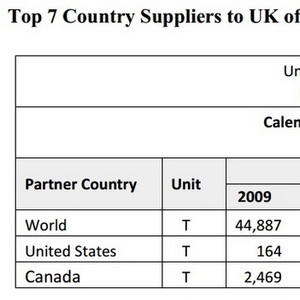GAIN report highlights status of U.K. pellet demand




USDA FAS GAIN
March 3, 2015
BY Erin Krueger
A report recently filed with the USDA Foreign Agricultural Service Global Agricultural Information Network focuses on the U.K. wood pellet market.
The report estimates the U.K. imported 4.6 million metric oven dried tons of wood pellets last year, making the country the largest importer of wood pellets in the world. The U.S. was the largest exporter of pellets last year, with an estimated 3.6 million metric tons sold overseas, 75 percent of which was destined for the U.K. The U.K.’s remaining pellet imports last year came primarily from Canada and other EU countries.
The report indicates the U.K. likely imported approximately $875 million worth of wood pellets last year, with about 60 percent, or $530 million, of that volume sourced from the U.S. Pellet demand in the U.K. is primarily linked to a small number of large-scale coal-fired power plants that have made the conversion to firing biomass. The report notes that pellet demand is expected to grow over the next several years as three additional power generation units convert to biomass. After that, the report predicts U.K. pellet demand for electricity production will plateau.
Advertisement
Advertisement
The U.K. currently produces approximately 10 million green metric tons of wood each year, which goes to a range of markets, including sawmills, panel board producers and heat generation. While the U.K. has made significant progress in developing wood-fuel supply chains, growing from 500,000 metric tons delivered to energy markets in 2007 to 1.5 million metric tons in 2010, the report stresses U.K. forests are relatively dispersed and the country lacks the wood volume or infrastructure that would allow this wood fiber to be supplied to the power sectors. According to the GAIN report, the U.K.’s largest generator now operates on pelletized material and did not buy a single ton of U.K. wood fiber in 2013. The U.K. currently predicts softwood production will peak at 12 million green tons in 2017-2021.
Bioenergy feedstocks from existing woodlands, forests, urban spaces and transport corridors, coproducts of the sawmill industry, development of short-rotation forestry and small round wood markets represent a significant potential contribution to the U.K. heat production. The report notes the U.K. Department of Energy and Climate Change currently estimates heat production potential could increase from 6-31 TWh to 13-34 TWh by 2030. At that level, 2.4 to 6.5 million oven dried tons of U.K. forestry resources would be used in heat production.
Regarding power, the report states that if all the proposed biomass power plants in the U.K. were up and running, capacity would be approximately 2,900 MW. About 12-13 million tons of biomass pellets would be needed to fuel those facilities, with almost none of that volume coming from the U.K. biomass market.
Advertisement
Advertisement
The U.K. produced an estimated 2.2 million metric tons of wood pellets last year, with production expected to increase to 2.4 million this year. The country imported 4.6 million metric tons of wood pellets in 2014, with that volume expected to increase to 5.5 million metric tons this year. The U.K. exported 120,000 metric tons of wood pellets last year, with 150,000 metric tons expected to be exported this year. Consumption of wood pellets reached 6.68 million metric tons last year, and is expected to reach 7.75 million metric tons this year. The country imported 2.8 million metric tons of wood pellets from the U.S. last year, with a value of $530 million. Imports from the U.S. are expected to increase to 3.58 million metric tons this year, with that volume valued at $680 million.
A full copy of the report can be downloaded from the USDA FAS GAIN website.
Upcoming Events





